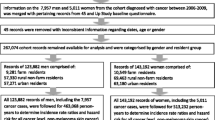Abstract
Objective: To investigate the risk of cancer among veterinarians in a large record-linkage study from Sweden. Methods: We used the nationwide, Swedish Cancer Environment Registry III, which links the Cancer Register data for 1971–1989 to the national population censuses from 1960 and 1970, to compare the incidence of cancer among male veterinarians to that of the remaining part of the active population using multivariable Poisson regression models and standardized incidence ratios. One thousand one hundred and seventy eight men classified as veterinarians or workers in the veterinary industry at either census were identified. Results: Veterinarians in the veterinary industry experienced increased risk of esophageal (relative risk (RR) 3.78, 95% confidence interval (CI) 1.42–10.09), colon (RR: 2.36, 95% CI: 1.42–3.91), pancreatic (RR: 2.10, 95% CI: 0.94–4.68) and brain (RR: 2.51, 95% CI: 1.04–6.03) cancers as well as melanoma of the skin (RR: 2.77, 95% CI: 1.24–6.17). Similar excess risks were observed when veterinarians were compared with individuals of similar socio-economic status. Conclusion: The increased risks of esophageal, colon, pancreatic and brain cancers as well as melanoma observed among veterinarians did not seem to be explained by the high socio-economic status of this occupational group. Therefore, it is possible that some of these results reflect the carcinogenicity of occupational exposures, including animal viruses, solar or ionizing radiations and anesthetics.
Similar content being viewed by others
References
Wiggins P, Schenker MB, Green R, Samuels S (1989) Prevalence of hazardous exposures in veterinary practice. Am J Ind Med 16: 55-66.
Fritschi L (2000) Cancer in veterinarians. Occup Environ Med 57: 289-297.
Blair A, HayesJr HM (1982) Mortality patterns among US veterinarians, 1947-1977: an expanded study. Int J Epidemiol 11: 391-397.
Miller JM, Beaumont JJ (1995) Suicide, cancer, and other causes of death among California veterinarians, 1960-1992. Am J Ind Med 27: 37-49.
Botts RP, Edlavitch S, Payne G (1966) Mortality of Missouri veterinarians. J Am Vet Med Assoc 149: 499-504.
Fasal E, Jackson EW, Klauber MR (1966) Mortality in California veterinarians. J Chronic Dis 19: 293-306.
Schnurrenberger PR, Martin RJ, Walker JF (1977) Mortality in Illinois veterinarians. J Am Vet Med Assoc 110: 1071-1075.
Kinlen LJ (1983) Mortality among British veterinary surgeons. Br Med J (Clin Res Ed) 287: 1017-1019.
Dos Santos Silva I (1999) Cancer Epidemiology: Principles and Methods. Lyon: International Agency for Research on cancer (IARC), p. 1.
Breslow NE, Day NE (1987) Statistical methods in cancer research. In: Breslow NE, Day NE, eds. The Design and Analysis of Cohort Studies. Vol. II [No. 82]. Lyon: International Agency for Research on Cancer (IARC), IARC Scientific Publications, pp. 1-406.
SS (Statistics Sweden) (1995) Swedish socioeconomic classification, 4. Reports on Statistical Co-ordination 1982. Stockholm: Statistics Sweden.
Hemmingsson T, Lundberg I, Romelsjo A, Alfredsson L (1997) Alcoholism in Social Classes and Occupations in Sweden. Int J Cancer 26: 584-591.
Rosen M, Wall S, Hanning M, Lindberg G, Nystrom L (1987) Smoking habits and their confounding effects among occupational groups in Sweden. Scand J Soc Med 15 233-240.
Johnson ES, Shorter C, Rider B, Jiles R (1997) Mortality from cancer and other diseases in poultry slaughtering/processing plants. Int J Epidemiol 26: 1142-1150.
Johnson ES, Dalmas D, Noss J, Matanoski GM (1995) Cancer mortality among workers in abattoirs and meatpacking plants: an update. Am J Ind Med 27: 389-403.
Chang F, Syrjanen S, Wang L, Syrjanen K (1992) Infectious agents in the etiology of esophageal cancer. Gastroenterology 103: 1336-1348.
Brackbill R, Frazier T, Shilling S (1988) Smoking characteristics of US workers, 1978-1980. Am J Ind Med 13: 5-41.
Sterling TD, Weinkam JJ (1976) Smoking characteristics by type of employment. J Occup Med 18: 743-754.
IARC Working Group (2000) Ionizing Radiation, Part 1: X-and Gamma-Radiation, and Neutrons. Vol. 75. Lyon: International Agency for Research on cancer (IARC), IARC Monographs on the Evaluation of the Carcinogenic Risks to Humans, pp. 1-492.
Ron E (1998) Ionizing radiation and cancer risk: evidence from epidemiology. Radiat Res 150: S30-S41.
Blair A, HayesJr HM (1980) Cancer and other causes of death among US veterinarians, 1966-1977. Int J Cancer 25: 181-185.
Doll R, Peto R (1977) Mortality among doctors in different occupations. Br Med J 1: 1433-1436.
IARC Working Group (1987) Overall Evaluations of Carcinogenicity: An Updating of IARC Mopnographs. Vol. 1-42. (Suppl. 7). Lyon: International Agency for Research on cancer (IARC), IARC Monographs on the Evaluation of the Carcinogenic Risks to Humans, pp. 1-440.
Armstrong BK, English DR (1996) Cutaneous malignant melanoma. In: Schottenfeld D, Fraumeni JF, eds. Cancer Epidemiology and Prevention, 2nd edn. Oxford: Oxford University Press, pp. 1282-1309.
IARC Working Group (1992) Solar and Ultraviolet Radiation. Vol. 55._ Lyon: International Agency for Research on cancer (IARC), IARC Monographs on the Evaluation of the Carcinogenic Risks to Humans, pp. 1-316.
Adami J, Gridley G, Nyren O, et al. (1999) Sunlight and non-Hodgkin's lymphoma: a population-based cohort study in Sweden. Int J Cancer 80: 641-645.
Preston-Martin S, Mack WJ (1996) Neoplasms of the nervous system. In: Schottenfeld D, Fraumeni JF, eds. Cancer Epidemiology and Prevention, 2nd edn. Oxford: Oxford University Press, pp. 1231-1281.
Persson B (1996) Occupational exposure and malignant lymphoma. Int J Occup Med Environ Health 9: 309-321.
Figgs LW, Dosemeci M, Blair A (1994) Risk of multiple myeloma by occupation and industry among men and women: a 24-state death certificate study. J Occup Med 36: 1210-1221.
Blair A, Zahm SH, Pearce NE, Heineman EF, Fraumeni JFJ (1992) Clues to cancer etiology from studies of farmers. Scan J Work Environ Health 18: 209-215.
Author information
Authors and Affiliations
Corresponding author
Rights and permissions
About this article
Cite this article
Travier, N., Gridley, G., Blair, A. et al. Cancer incidence among male Swedish veterinarians and other workers of the veterinary industry: a record-linkage study. Cancer Causes Control 14, 587–593 (2003). https://doi.org/10.1023/A:1024834927738
Issue Date:
DOI: https://doi.org/10.1023/A:1024834927738



